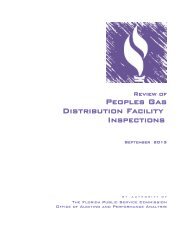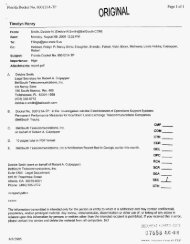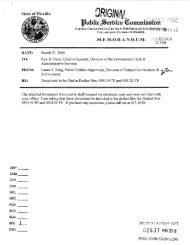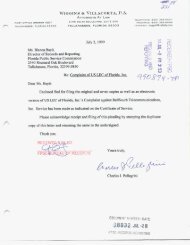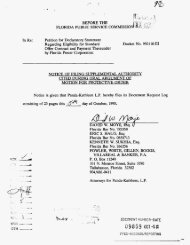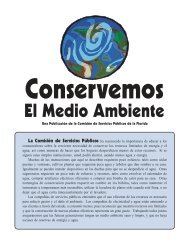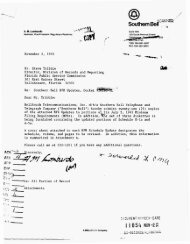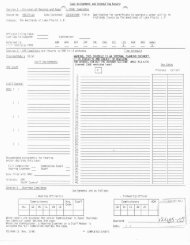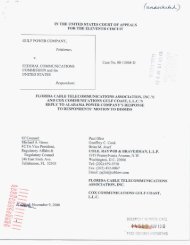2 - Public Service Commission
2 - Public Service Commission
2 - Public Service Commission
You also want an ePaper? Increase the reach of your titles
YUMPU automatically turns print PDFs into web optimized ePapers that Google loves.
ORDER NO. PSC-08-0846-FOF-WS<br />
DOCKET NO. 080006-WS<br />
PAGE 4<br />
Docket NOS. 090445-WS a Ow59-WS<br />
Utilities Grove Land and Bluefield<br />
Witness: Hartman<br />
Exhibit GCH-2 Page 4 of 37<br />
company must be used. Witness Rothschild argues that the work done by Modigliani and Miller<br />
is generally regarded as the breakthrough work on the relationship between capital structure and<br />
cost of capital, and that this work forms the basis for the leverage formula used by us3 Witness<br />
Rothschild argues that Modigliani and Miller showed that, if it were not for income taxes and<br />
bankruptcy risk, the capital structure selected by a company would have no impact on the overall<br />
cost of capital. Witness Rothschild believes that the cost of debt must vary in response to<br />
changes in the level of common equity in a utility’s capital structure since the overall cost of<br />
capital remains constant over different capital structures and the cost of equity varies depending<br />
on the equity ratio. He asserts that the relationship between bond ratings and capital structure for<br />
the natural gas index shows that the cost of debt does vary in relation to the equity ratio.<br />
Rather than merely assign the same cost of capital to all WAW utilities, witness<br />
Rothschild notes the concept behind the leverage formula begins by recognizing that each utility<br />
uses a different capital structure. He believes that, because utilities use different capital<br />
structures, even if the overall cost of capital were the same from company to company, the cost<br />
of equity would change due to variations in the capital structures used. In other words, the<br />
witness believes two WAW companies that have the same business risk will have different<br />
financial risk if they use different capital structures. He states that the Modigliani and Miller<br />
principle tells us that as the percentage of common equity goes up, financial risk goes down,<br />
which causes both the cost of debt and the cost of equity to go down. Witness Rothschild argues<br />
that the expectation of the lower cost of debt must be modeled into the determination of the<br />
leverage formula for it to produce a correct answer.<br />
UI witness Ahern testifies that holding the debt cost rate constant for purposes of deriving<br />
the WAW ROE leverage formula is reasonable for two reasons. First, she states that the revenue<br />
requirement formula ensures that the regulated utility will receive sufficient earnings to<br />
compensate for the expenses it incurs to service both its debt and equity obligations. Witness<br />
Ahem adds that, in the ratemaking process, the embedded cost of debt is utilized in the<br />
calculation of the overall rate of return. In addition, she states that the cost of debt is a function<br />
of many factors. The bond rating process itself indicates that bond ratings are not simply and<br />
exclusively a function of debt ratios, especially historical or point in time debt ratios.<br />
Witness Ahem testifies that the current leverage formula assumes that if Florida WAW<br />
utilities had bonds which were rated, they would be rated Baa3 by Moody’s, which is equivalent<br />
to a BBB- by Standard & Poor’s (S&P). She notes the bond rating process is comprehensive,<br />
both qualitative and quantitative, and does not focus exclusively on the debt ratio. Witness<br />
Ahern explains that the business risWfinancial risk matrix indicates that utilities with a BBB-<br />
rating and a weak business risk profile would likely have a modest financial risk profile, and<br />
those with a strong business risk profile would likely have an aggressive financial risk profile.<br />
The range of financial risk indicative ratios published by S&P are shown on page 12 of Exhibit<br />
23. The total debt to total capital indicative ratios for utilities with a modest financial risk profile<br />
Franc0 Modigliani and Merton Miller, professors at the Graduate School of Industrial Administration at the<br />
Camegie Mellon University, in 1958 developed the theorem that forms the basis for modem thinking on capital<br />
structure. The basic theorem states that, in the absence of taxes, bankruptcy costs, asymmetric information, and an<br />
inefficient market, the value of a firm is unaffected by the mix of capital used to finance its operations.




